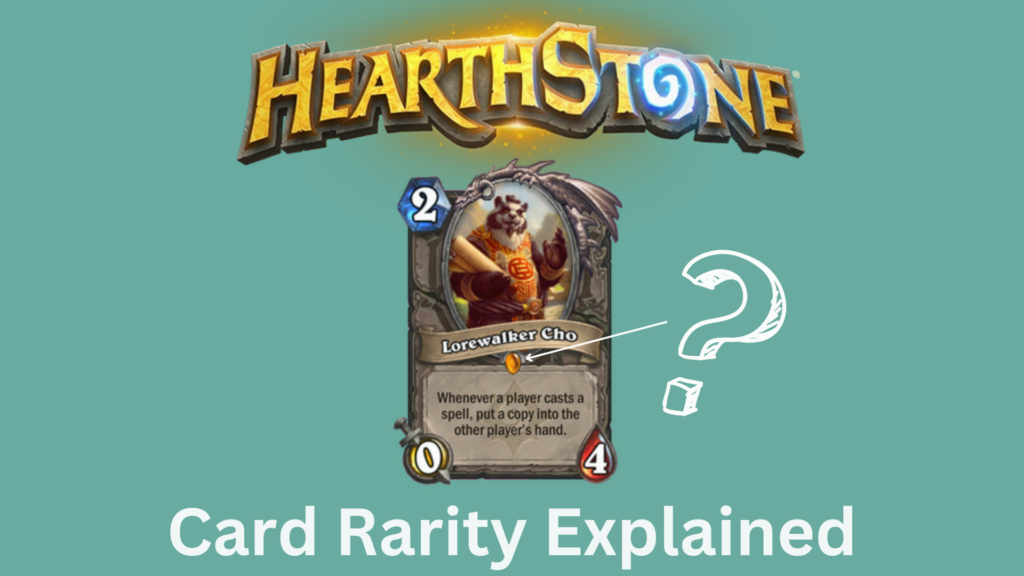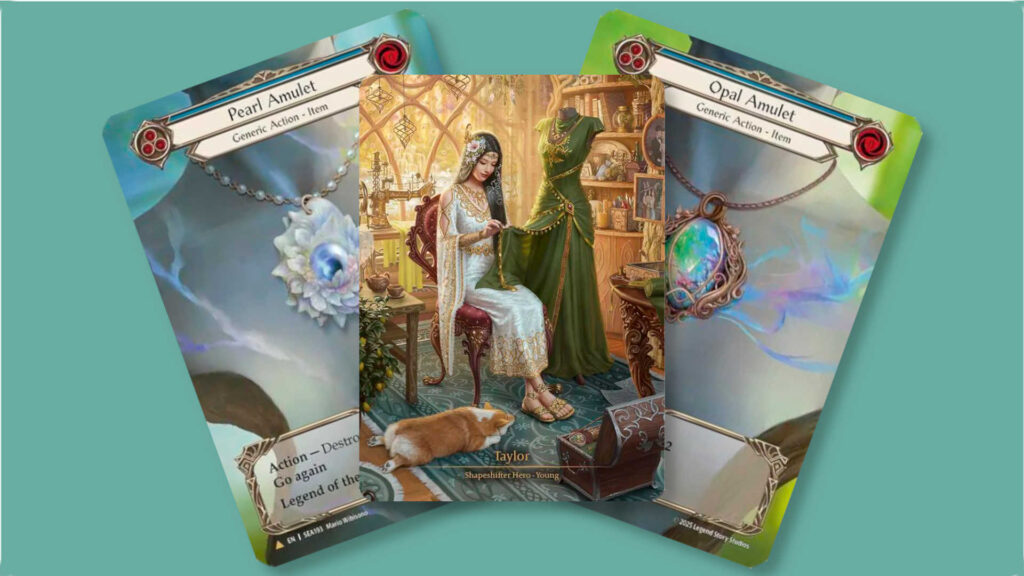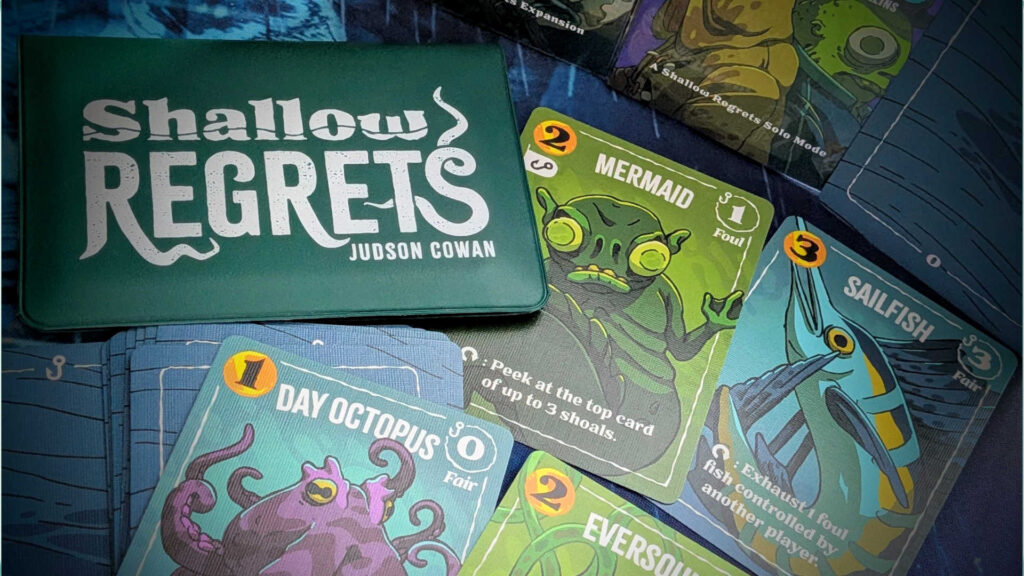Hearthstone Card Rarities Explained
If you’re new to Hearthstone, you’ll quickly notice that not all cards are created equal. They vary by gem color and crafting cost, for starters. And all of this comes down to card rarity!
Rarities in Hearthstone aren’t much different from those in other card games like Magic, Gwent, Legends of Runeterra, or really, almost any other online collectible card game.
Table of Contents
ToggleAll Card Rarities in Hearthstone

In Hearthstone, cards come in four different rarities:
- Common
- Rare
- Epic
- Legendary
To view the number of cards of each rarity you have, simply enter the rarity type in the search bar while browsing your collection, as shown in the image below: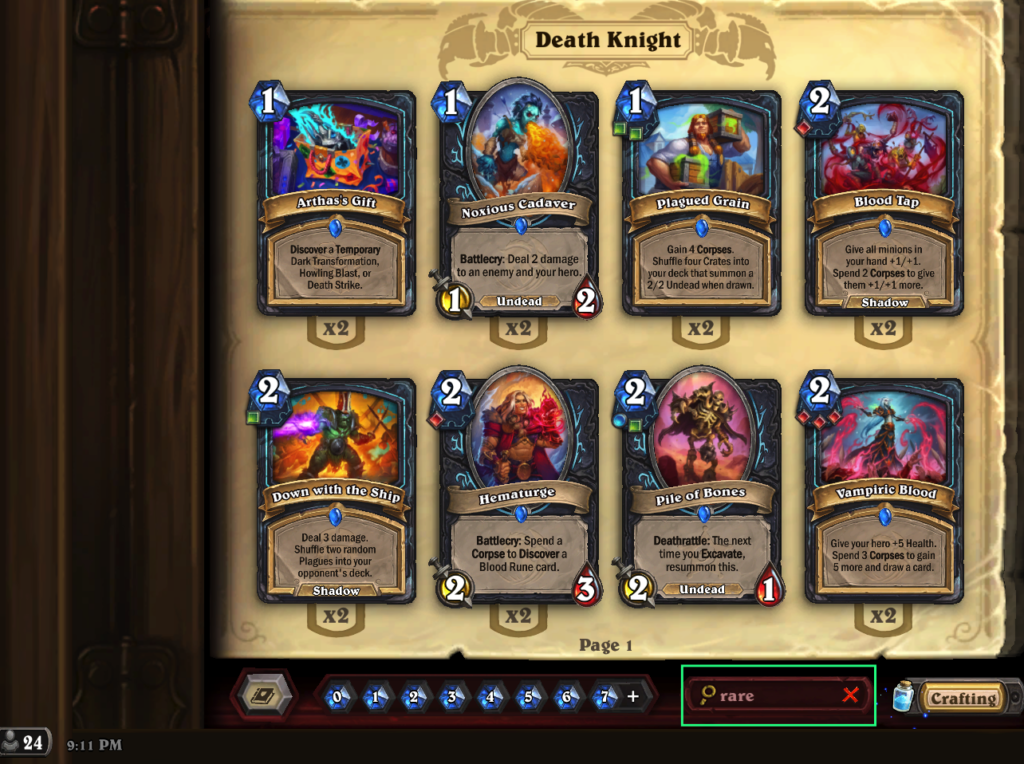
Each rarity influences key aspects of a card, such as:
- gem color
- crafting cost
- disenchant value
- complexity of the card (well, kind of – I’ll explain later)
Interestingly, you should know that a card’s rarity doesn’t necessarily determine its power. In fact, card rarity is more about Hearthstone’s economy than balance or anything else, which we’ll explain further in this article.
As a fun fact, there used to be one more rarity in Hearthstone, which was known as “free.” Cards with a free rarity did not have a gem, and you would obtain them by simply playing the game and levelling up each class. However, after the Year of the Pegasus’s release (mid-2024), all cards have some kind of rarity assigned, even the ones you get without spending any dust.
Common Cards
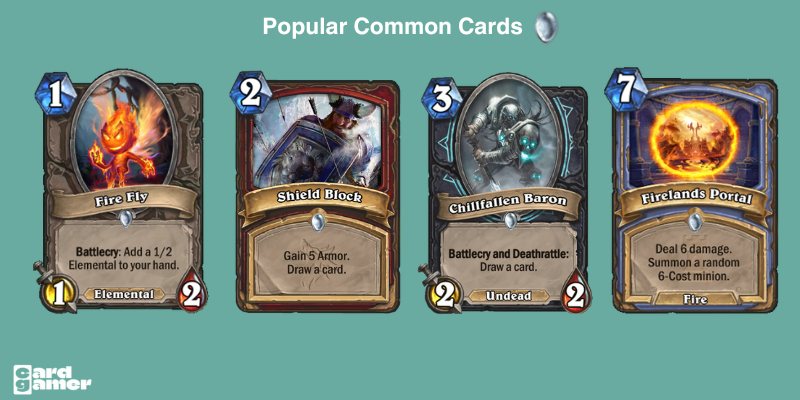
| Gem color | White |
| Crafting cost (regular version) | 40 Arcane Dust |
| Crafting cost (golden version) | 400 Arcane Dust |
| Upgrade cost (from regular to golden) | 360 Arcane Dust |
| Disenchant value (regular version) | 5 Arcane Dust |
| Disenchant value (golden version) | 50 Arcane Dust |
Common cards are the “most basic” and frequently encountered in Hearthstone; approximately 70% of cards in any pack are common, making them super easy to collect.
They often feature straightforward abilities and are versatile enough to fit into almost any deck archetype. However, their simplicity doesn’t mean they’re weak; oh, not at all. It’s just that common cards rarely rely on complex synergies, which is why they’re great for new players to start learning the game with.
Rare Cards
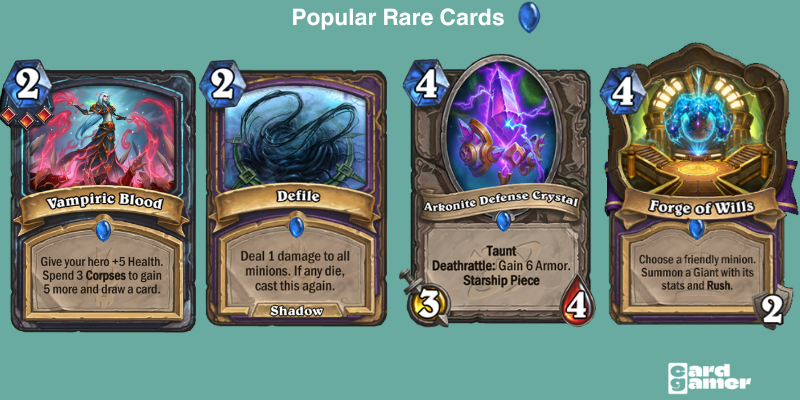
| Gem color | Blue |
| Crafting cost (regular version) | 100 Arcane Dust |
| Crafting cost (golden version) | 800 Arcane Dust |
| Upgrade cost (from regular to golden) | 700 Arcane Dust |
| Disenchant value (regular version) | 20 Arcane Dust |
| Disenchant value (golden version) | 100 Arcane Dust |
Rare cards usually have that balance between versatility and complexity, and they offer a bit more specialization than commons. In fact, this is a rarity that has the most “counter-cards” in it, meaning those that disrupt or negate an opponent’s strategy.
In short, rare cards typically come with abilities that can help out or counter some specific strategies without being too “niche” at the same time.
Epic Cards
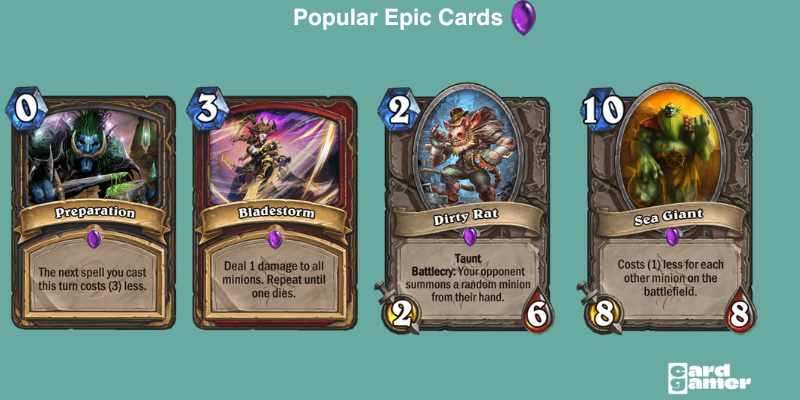
| Gem color | Purple |
| Crafting cost (regular version) | 400 Arcane Dust |
| Crafting cost (golden version) | 1600 Arcane Dust |
| Upgrade cost (from regular to golden) | 1200 Arcane Dust |
| Disenchant value (regular version) | 100 Arcane Dust |
| Disenchant value (golden version) | 400 Arcane Dust |
There were many approaches to epic cards by Blizzard’s balance team in the past. However, since 2023, epic cards bring more complex effects to the table that require more synergy to pull off… well, unless it’s a Druid card; then the effect is just absolutely OP for no reason.
No worries, that was a joke, and the more you play Hearthstone, you’ll learn how accurate it is. Sadly.
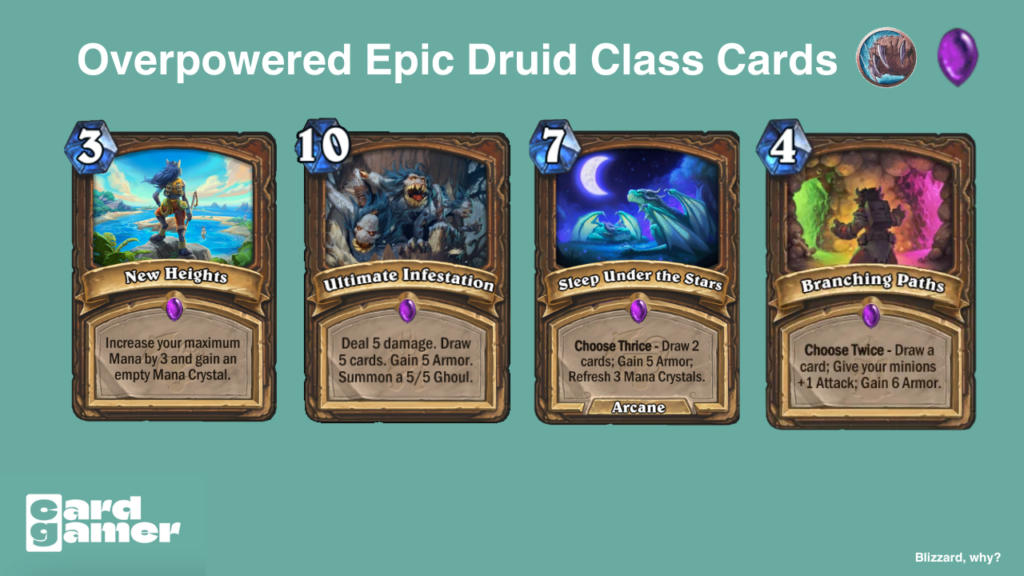
Epic cards usually require specific conditions or synergies to unleash their full potential, making them less versatile, but highly impactful when used correctly. Their niche nature means they’re best utilized in decks built around a specific strategy or combo.
But here’s the deal: as these cards are so niche and powerful at the same time, they’re usually must-haves to craft when building an entirely new deck archetype.
And as you may have noticed, epic cards are quite costly. And if you add to the fact that you have to craft two copies of a single epic for a deck…. Yeah, you just learned one of many ways Blizzard can make money off Hearthstone!
Legendary Cards

| Gem color | Orange |
| Crafting cost (regular version) | 1600 Arcane Dust |
| Crafting cost (golden version) | 3200 Arcane Dust |
| Upgrade cost (from regular to golden) | 1600 Arcane Dust |
| Disenchant value (regular version) | 400 Arcane Dust |
| Disenchant value (golden version) | 1600 Arcane Dust |
| Unique aspect | You can only have one copy of each Legendary card in your deck |
Lastly, we have legendary cards — marked by an orange gem, featuring a unique dragon border, and coming with a very high crafting cost. You should know that legendaries are typically quite specialized and focused on supporting a single archetype. Again, this isn’t a hard rule, but that’s usually how it goes.
Legendary cards often require a well-thought-out deck built around their abilities to truly maximize their potential; which makes sense, as we don’t want the game to be pay-to-win, do we? However, Blizzard also doesn’t forget about the necessity of making money from the game, which is why so many legendaries released in the Year of the Pegasus were deck-defining (meaning you couldn’t craft an archetype without them).
An important thing to note is that you can only have one copy of each legendary card in your deck. Since you can’t rely on drawing multiple copies, you need to think carefully about how and when to play your legendary to get the most out of its unique abilities.
Hearthstone Card Pack Rarity Statistics
Every Hearthstone pack you open is guaranteed to contain at least one rare or higher rarity card. That means you’ll always get at least one card that’s rare, epic, or legendary in every five-card pack. So, no matter what, you’re never walking away with just commons.
While Blizzard hasn’t disclosed the exact drop rates for each card rarity, they have provided some average probabilities. Combined with community data, here’s an overview of the likelihood of obtaining cards by rarity:
| Rarity | Percentages of cards opened (approx.) | Chance of golden version (approx.) |
| Common | 71.4% | 2.1% |
| Rare | 23.8% | 5.5% |
| Epic | 4.5% | 5.5% |
| Legendary | 0.9% | 8.4% |
The Pity Timer System
When opening card packs in Hearthstone, you might sometimes feel unlucky if you don’t get any high-rarity cards after several tries. To address this, Hearthstone has a built-in feature called the Pity Timer System, which assures that you will eventually receive epic or legendary cards if you haven’t pulled any after opening a certain number of packs.
Here’s how it works:
- Epic cards: If you haven’t opened an epic card in 10 consecutive packs, the Pity Timer guarantees that the next pack will contain at least one epic card.
- Legendary cards: Similarly, if you haven’t found a legendary card in 40 consecutive packs, the system ensures that the next pack will include a legendary.
Once you open an epic or legendary card, the Pity Timer resets for that rarity.
The best part is that the Pity Timer is independent for each card set; if you’re opening packs from different expansions, the count resets for each one. For example, opening 20 packs from one set without a legendary doesn’t affect the Pity Timer for another set.
Duplicate Protection
Hearthstone has a built-in duplicate protection system that ensures you get new cards rather than duplicates. Honestly, this is probably one of the best things introduced to the game, and it’s simple!
When you open a legendary card, it’s guaranteed to be one you don’t already own, unless you’ve collected all the legendaries from that set. As for epics, rares, and commons, you won’t receive more copies than you can use in a deck until you’ve collected two copies of every card of that rarity in the set.
First Ten Pack Legendary Rule
Lastly, another generous rule: for any card expansion, you’re guaranteed to receive at least one legendary card within your first ten packs opened from that set. However, The “First Ten Pack Legendary Rule” is independent of the Pity Timer, meaning that your guaranteed legendary in the first ten packs doesn’t reset or affect the Pity Timer count for subsequent legendaries.
To get started playing Hearthstone, you can download it here.
If you like Hearthstone, you might like Magic Arena as well! Follow along as Cooper details his journey climbing the Mythic ladder, starting here.

